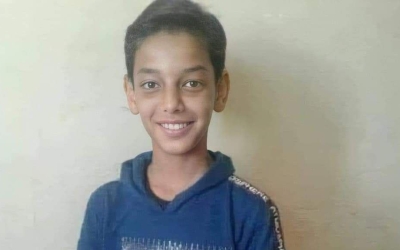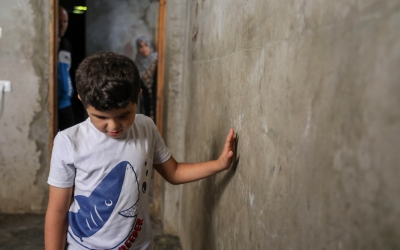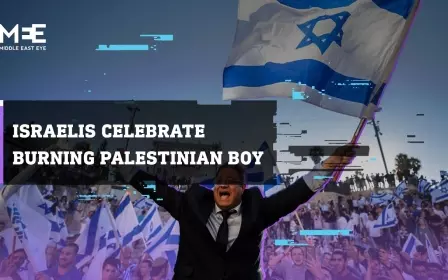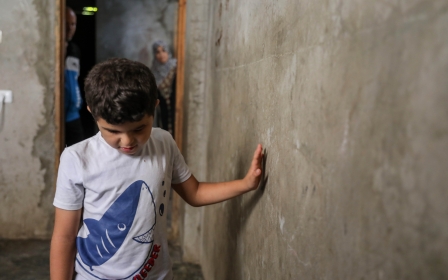Israel jets strike Gaza hours after Palestinians injured during protest

Israel attacked two sites in the besieged Gaza Strip overnight into Sunday, hours after at least 11 Palestinian protesters in the besieged enclave were wounded by Israeli forces.
The strikes, which the army claimed were aimed at Hamas targets, came shortly after the launch of incendiary balloons from Gaza into southern Israel, sparking two fires.
A correspondent for official Palestinian Authority (PA) news agency Wafa said that fighter jets attacked a location on Shuhada Street, south of Gaza City, with four missiles, causing a fire to erupt at the site.
The news agency said the planes also struck farmlands near the town of Beit Hanoun in northern Gaza , causing physical damage but no injuries.
According to the Israeli army, the "fighter jets struck a Hamas military compound used for manufacturing weapons and training as well as an entrance to a terror tunnel adjacent to Jabalia".
"The strikes were in response to Hamas launching incendiary balloons into Israeli territory and the violent riots that took place yesterday," the army added in a statement.
Photos of the damage from the air strikes near Beit Hanoun released by AFP showed civilians inspecting their shattered homes.
The Palestinian Hamas movement, meanwhile, vowed on Saturday afternoon that it would keep pressuring Israel to lift its 14-year blockade on Gaza.
"The blockade has turned life in the Gaza Strip into an unlivable hell. The relief that Israel said it would give to Palestinians, like the entry of some goods and providing permits to merchants to leave the Strip, do not answer the minimum requirements," a statement from Palestinian factions in Gaza received by newspaper Haaretz read. "Therefore, our demand from the mediators is to fully remove the blockade."
Live fire
The attacks came after an Israeli crackdown earlier on Saturday on Palestinians demonstrating near the fence that separates Gaza from Israel.
The Israeli army fired tear gas, live bullets and stun grenades at the Palestinians, who were denouncing the Israeli-led blockade of the enclave
The health ministry in Gaza said 11 Palestinians had been hurt, three of them by live fire.
Hours earlier, mourners laid to rest Omar Hassan Abu al-Nil, 12, who died of his wounds a week after being shot by Israeli forces during a similar protest.
Also on Saturday evening, two fires broke out in the Eshkol region near Gaza, Israeli firefighters said, blaming them on incendiary balloons launched from Gaza.
Speaking in Washington, where he had met with US President Joe Biden, Israeli Prime Minister Naftali Bennett said he held Hamas, the de facto ruling party in Gaza, responsible for any unrest in the Palestinian enclave.
"As I have already said, our actions in Gaza will serve our interests," he told reporters before boarding a plane back to Israel.
"As far as I'm concerned, the address [of those responsible] has been and remains Hamas."
Crippling blockade
Israel has maintained a crippling blockade of the Gaza Strip since 2007, which critics say amounts to collective punishment of the impoverished enclave's two million residents.
Egypt also upholds the siege, restricting movement in and out of Gaza on its border.
In 2018, residents of Gaza began a protest movement demanding an end to the blockade and the right for Palestinian refugees to return to lands they fled or were expelled from when Israel was founded.
The weekly demonstrations were eventually suspended after more than a year after Israeli forces killed some 350 Palestinians in Gaza.
On Sunday, Egypt reopened the Rafah crossing with the Gaza Strip to allow Palestinians to leave, after having partially reopened the crossing on Thursday for travel into Gaza.
Rafah, Gaza's only gateway to the outside world not controlled by Israel, was closed by Egypt on 23 August.
Egypt gave no reason for the move, but Palestinian sources in Gaza said it was due to the recent Palestinian protests.
Middle East Eye delivers independent and unrivalled coverage and analysis of the Middle East, North Africa and beyond. To learn more about republishing this content and the associated fees, please fill out this form. More about MEE can be found here.






